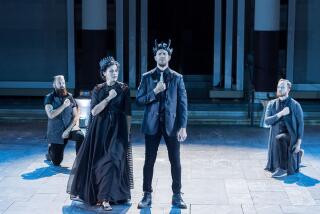Ancient Myth of Orpheus Makes Visually Stunning, Futuristic Leap
- Share via
For nearly 400 years, artists have been creating operas about Orpheus and Eurydice--mythic lovers whose story speaks to every generation about the transforming power of human emotion and the way conflicting needs invite disaster in a relationship. Now high-tech Canadian theater visionaries Michel Lemieux and Victor Pilon have turned the myth into a coldly beautiful neo-Romantic media opera: “Orfeo,” an 80-minute meditation on separation and loss told through a series of haunting holographic images.
At the Carpenter Performing Arts Center in Long Beach on Friday, those images marked them as deeply serious innovators who use experimental projection techniques purposefully to freshen a classic tale. Without requiring the audience to wear glasses or goggles, Lemieux and Pilon project moving, three-dimensional shapes into a stage space dominated by real objects and live performers. As in the ballet classic “Giselle,” we see a living man reach out to the life-size, moving image of his dead love standing beside him only to find her a bodiless phantom. But this time, the illusion isn’t achieved merely through pantomime. Thanks to Lemieux, Pilon and choreographer Ginette Prevost, she really does dissolve in his arms--and he can reach right through her.
Played by Rodrigue Proteau, Orpheus is weighty, intense, contemporary, very much alive. But after her death, Eurydice is represented by a technological facsimile of Julie Slater: a pale, incorporeal trick of the light that sometimes expands to supernatural scale or divides into multiple reflections, always as mobile and fully dimensional as Proteau. He’s actual, she’s virtual, and that difference alone dramatizes the tragic gulf separating the characters they play.
Shuttling between the living and the dead, Peter James as the grotesque Heurtebise soon becomes central to the updated story, eventually reuniting the lovers to gain his own freedom. And, helping to shape the drama, there’s more technological excellence to appreciate: vivid projected backgrounds plus an atmospheric sound-score, along with ghostly virtual extras who materialize and move in a manner no living performers could match, sometimes smearing in the air as if losing their form to become pure energy. Most of the virtual imagery is created live at every performance, though the projections of scenic environments and the extras are reportedly preset.
Obviously the Lemieux-Pilon “Orfeo” represents a wondrous futuristic spectacle, but it also always manages to stay on track expressively, avoiding the excesses of its wayward theater-of-projection predecessors: the narcissistic personal display of Daniel Ezralow’s “Mandala,” for example, or the arbitrary, gee-whiz diversions of Robert Wilson’s “Monsters of Grace.” No macho muscle-flexing here, no cute polar bear, no egos on parade.
*
However, there’s a cost to all this image manipulation: To accommodate the projections, “Orfeo” takes place on a platform so far upstage of the curtain line that the immediacy of live performance nearly vanishes. And, perhaps inevitably, the stage remains so dark throughout that a kind of sensory-deprivation anxiety eventually begins to gnaw at the viewer--a feeling appropriate, perhaps, for a story culminating in the oppressive underworld, but deadening emotionally despite the poignancy of the narrative. Lemieux and Pilon may be able to turn creative fantasy into virtual reality, but their “Orfeo” ultimately remains too remote and dim to make us care.
Featuring resourceful lighting designs by Axel Morgenthaler and serviceable costumes by Gabriel Tsampalieros and Carole Courtois, “Orfeo” had its premiere in Montreal last November and played 10 days ago at the Kennedy Center in Washington. It moves next to Ottawa; no further local performances are scheduled.
More to Read
The biggest entertainment stories
Get our big stories about Hollywood, film, television, music, arts, culture and more right in your inbox as soon as they publish.
You may occasionally receive promotional content from the Los Angeles Times.










